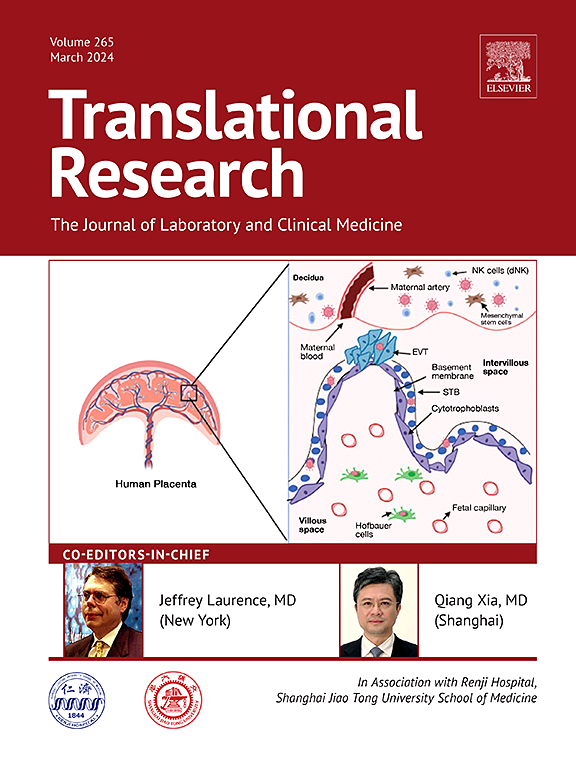sFRP5通过抑制巨噬细胞的JNK/TLR9通路改善动脉粥样硬化。
IF 5.9
2区 医学
Q1 MEDICAL LABORATORY TECHNOLOGY
引用次数: 0
摘要
分泌性卷曲相关蛋白5 (sFRP5)是一种抗炎脂肪因子,在多种疾病中起着至关重要的作用,其在冠状动脉疾病(CAD)患者的血清水平较低。然而,其在动脉粥样硬化中的作用尚不清楚。因此,我们研究了sFRP5与斑块稳定性之间的关系,以及动脉粥样硬化的分子机制。在冠心病患者中,血清sFRP5水平与斑块稳定性呈正相关,斑块稳定性是薄帽纤维粥样硬化(TCFAs)的预测因子。重组sFRP5 (r-sFRP5)补充显著增加ApoE-/-小鼠斑块稳定性和改善动脉粥样硬化进展。主动脉rna测序(RNA-seq)显示sfrp5介导的炎症细胞调节。我们的实验证实了sFRP5抑制炎症和巨噬细胞迁移。在机制上,toll样受体9 (TLR9)被确定为sFRP5的下游靶点,sFRP5通过降低c-Jun n -末端激酶(JNK)磷酸化来抑制TLR9的表达。这些研究结果表明,血清sFRP5水平与斑块稳定性有关,并通过抑制JNK/TLR9通路减轻炎症和巨噬细胞浸润,从而改善动脉粥样硬化的进展,从而在动脉粥样硬化中发挥保护作用。这项研究强调了sFRP5作为动脉粥样硬化斑块稳定性的生物标志物和治疗靶点的潜力。本文章由计算机程序翻译,如有差异,请以英文原文为准。
sFRP5 ameliorates atherosclerosis by suppressing the JNK/TLR9 pathway in macrophages
Secreted frizzled related protein 5 (sFRP5), an anti-inflammatory adipokine, plays a crucial role in various diseases, and its serum levels are low in patients with coronary artery disease (CAD). However, its role in atherosclerosis remains unclear. Therefore, we investigated the correlation between sFRP5 and plaque stability, along with the molecular mechanisms underlying atherosclerosis. In patients with CAD, serum sFRP5 levels were positively correlated with plaque stability, a predictor of thin-cap fibroatheromas (TCFAs). Recombinant sFRP5 (r-sFRP5) supplementation significantly increased plaque stability and ameliorated atherosclerosis progression in ApoE-/- mice. Aortic RNA-sequencing (RNA-seq) revealed sFRP5-mediated regulation in inflammatory cells. Our experiments confirmed that sFRP5 inhibits inflammation and macrophage migration. Mechanistically, Toll-like receptor 9 (TLR9) was identified as a downstream target of sFRP5, and sFRP5 suppressed TLR9 expression by decreasing c-Jun N-terminal kinase (JNK) phosphorylation. These findings suggest that serum sFRP5 levels are associated with plaque stability and play a protective role in atherosclerosis by attenuating inflammation and macrophage infiltration via inhibition of the JNK/TLR9 pathway, thereby ameliorating the progression of atherosclerosis. This study highlights the potential of sFRP5 as both a biomarker and therapeutic target for plaque stability in atherosclerosis.
求助全文
通过发布文献求助,成功后即可免费获取论文全文。
去求助
来源期刊

Translational Research
医学-医学:内科
CiteScore
15.70
自引率
0.00%
发文量
195
审稿时长
14 days
期刊介绍:
Translational Research (formerly The Journal of Laboratory and Clinical Medicine) delivers original investigations in the broad fields of laboratory, clinical, and public health research. Published monthly since 1915, it keeps readers up-to-date on significant biomedical research from all subspecialties of medicine.
 求助内容:
求助内容: 应助结果提醒方式:
应助结果提醒方式:


